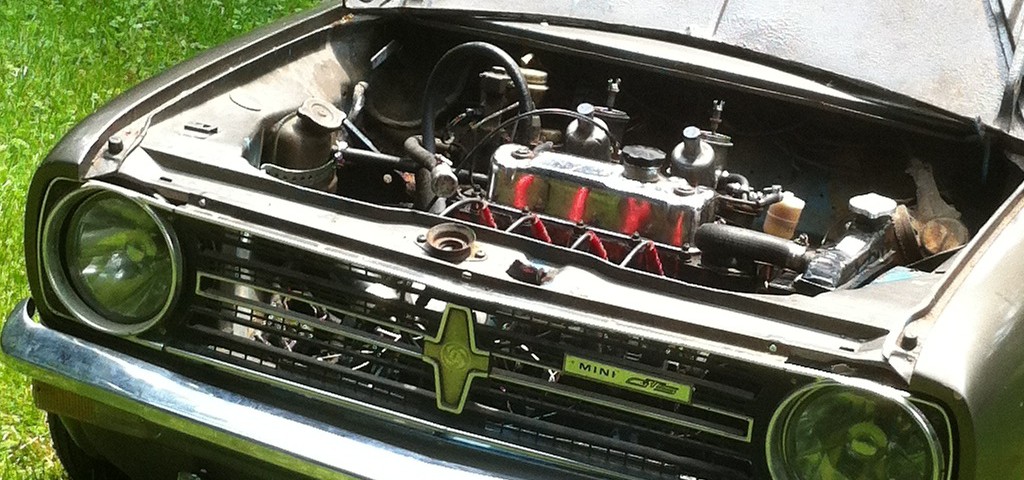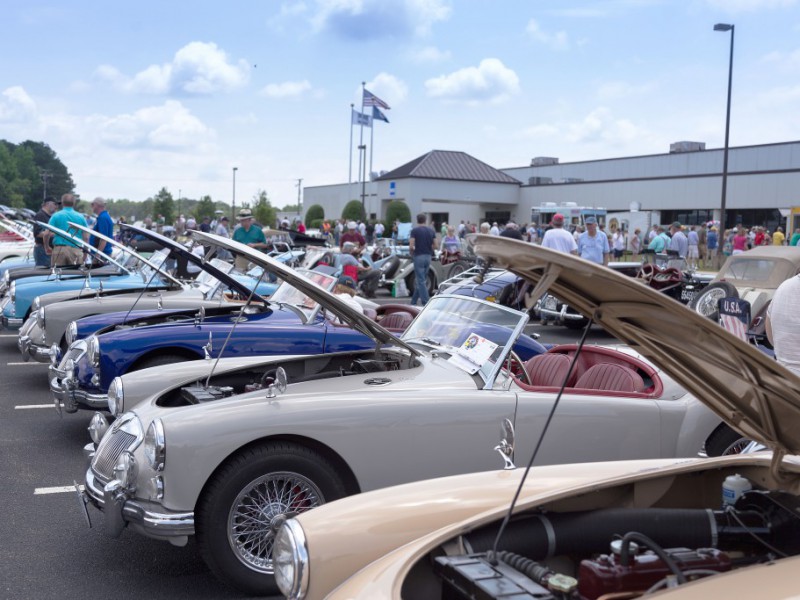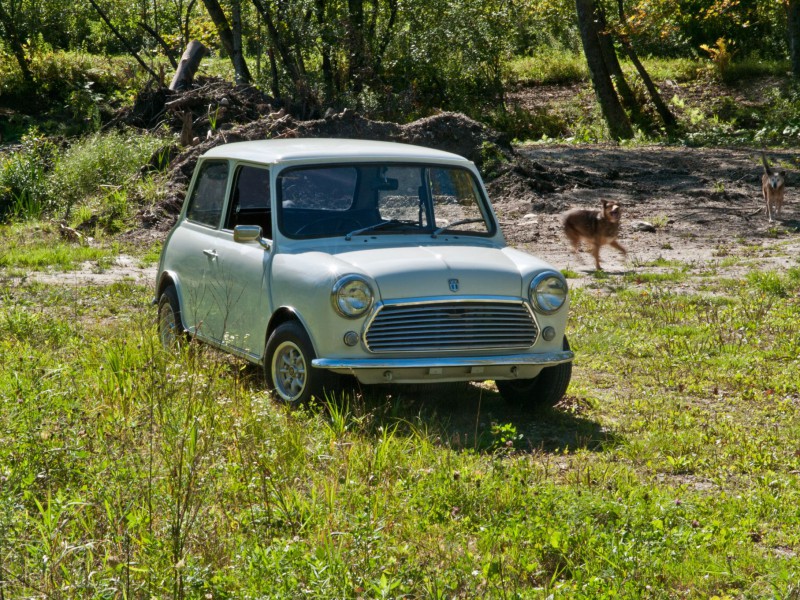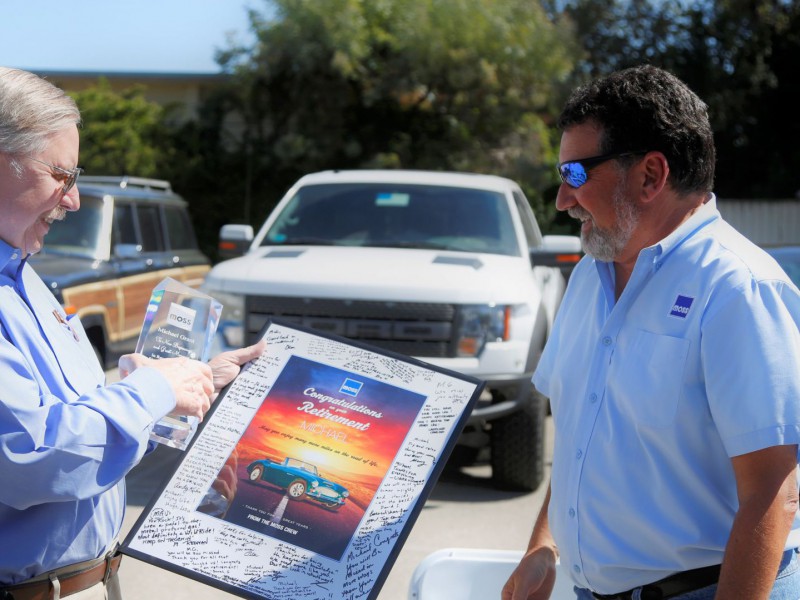By John Schein
In the past, the fabric of Mini history was thought to have been pulled asunder by the 1969 separation of John Cooper Racing from BMC. In reality it was kept intact, however, you had to travel to South Africa to find this small but important link in the Mini’s sporting legacy.
When the little ‘Orange Box,’ the original Mini so named for its paint color, was first unveiled, the guest list included John Cooper, maker of Formula 1 racing cars. Cooper was so taken with the Orange Box that he ordered nine works cars for his engineers to modify for racing and one to drive himself. In addition, Cooper turned to his pre-war motor racing friend, Alex Issigonis, to propose a joint venture between BMC and Cooper Racing. Cooper modifications increased engine capacity, had a higher gearing ratio at the top end, and increased braking to compensate for the increased power. The exterior of the Orange Box was left largely unaltered. It is from these cars that the legend of the Mini Cooper was born.
The Austin-Morris Mini Cooper was the pride of BMC. The success of the Cooper, however, could not reverse the significant financial difficulties that lay ahead. By 1962, plans were in the works for the merger of BMC and Leyland Motors. At one point the new company, called British Leyland, was the largest auto manufacturer in the world.
British Leyland was infected by an Empire mentality. After World War II, Austin and Morris auto companies as well as Leyland had spread worldwide, with assembly lines manufacturing CKD (completely knocked down) cars throughout the world. The concept was that the larger, more valuable components would be manufactured in the UK and shipped overseas to be assembled by local workforces, thus lowering labor costs and building product loyalty. British Leyland assembly lines were as far flung as Australia, New Zealand, South Africa, and Peru, as well as in European countries such as Belgium, Italy, and Spain. The Australian, South African, and Italian facilities had especially important associations with the Mini Cooper: in Australia it was the 1275 GT police cars, in South Africa the GTS, and in Italy the Innocetti 1300.

Unfortunately, the association of Leyland with John Cooper Racing collapsed in 1969 and in order for Leyland to remain in the lucrative sporty small family cars market, the first significant changes were made to the Mini in almost 15 years. In the UK, the Mini Clubman 1275 GT was introduced to satisfy the sporting drivers in the English market. The 1275 GT, was originally manufactured in the UK, but by 1971, CKD containers had arrived for assembly at the South African Blackheath plant.
The Austin and Morris operations of BMC, and later British Leyland, were the early mainstays of the South African auto industry. In 1955, the Austin Motor Car Company had begun assembling the Austin Cambridge at the Cape Town Blackheath plant. In 1961 when the Austin and Morris Coopers were introduced into Cape Town, the plant assembled several hundred Coopers from CKD parts. However, changes were afoot. By 1966, the Cooper blocks were being cast locally in two, one-ton electrobuckets at the Gering Foundry in Elise River and were bored at the milling facility at Blackheath. Thus, when the 1969 decision to drop the Mini Cooper line altogether was finalized in England, Blackheath was already well positioned to custom manufacture their own 1275 S blocks.
The Blackheath plant also assembled a range of other Leyland vehicles—from Land Rover to Jaguar, to Triumph, and even the Morris Minor. With the introduction of the English Clubman 1275 GT in 1971, the Blackheath facility now both manufactured and assembled complete cars in South Africa using a limited number of English components and steel from the Pressed Steel facility in Pretoria, owned by Budd Motor Company USA.
The flat nose version of the 1275 GT, had many features in common with the Cooper S. The engineers at Cape Town, led by Ralph Clark, had been tweaking the Cooper 1275 S for five years for South African racing purposes. This group immediately turned their attention to the creation of a 1275 GTS—which would become known locally as the Leyland Cooper. This level of modification was possible because British Leyland South Africa was a wholly owned and privately listed subsidiary of British Leyland, so they had the corporate privilege which allowed them to take actions in South Africa that would not have happened had they been part of British Leyland UK.
At the South African plant, they started by increasing the bore of the block and shortening the stroke, highly polishing the combustion chamber, cross drilling the crank, and adding aluminum pistons and new steel-alloy valves. After all was said and done, the GTS tested one MPH faster than the Cooper S. In addition, a large 35-litre fuel tank replaced the two small tanks, larger 8 ¼-inch disc brakes were sized to 12-inch tires, and a heavy-duty oil pump replaced the oil cooler. Indeed, the Cooper by Leyland advertisement which read: “For little old ladies, it ain’t.” hit the mark.

Beyond the improvements to the power aspects of the GTS, the car also received a new dash with a small glove compartment, an instrument panel with the first tachometer in Mini history, a leather-clad steering wheel, and a key-locking steering column instead of the center console key location. Mechanically, a new dual-circuit braking system was added and the new enlarged brakes meant the disappearance of the vacuum assist master cylinder. New bucket seats with headrests also were designed for the South African Minis, unfortunately forgetting that the front seat would then not tilt forward to allow access to the back seat. Finally, the overall appearance of the car was changed by the addition of chrome strips to the front grill, tinted glass, and exterior rearview mirrors on both left and right.
By 1973, the new GTS was acclaimed as the ‘New Cooper,’ and became the choice of racing aficionados in South Africa, while the base model with its 1000cc motor was produced for the general public as the ‘people’s car.’

Given all the accolades about the GTS, one wonders why it hides in the annals of Mini History. The answer lies in understanding that the fame of the 998cc and 1275 S Coopers came from their success on world-recognized racetracks. The first Coopers were small, powerful, winners of race after race and rally after rally. They were the hit of Europe. The GTS on the other hand began at a time when the Republic of South Africa was being racially divided into Bantustans, and Europe was sanctioning South Africa because of the racial policy. The GTS and other Leykor works cars were made by local talent and raced only in South Africa. The very name “Leykor” itself shows the impact of the South African politics at the time. Leyland did not wish to be associated with the racial policies but they did wish to do business there, so they created the name Leykor out of Leyland and Korpporatse, the Afrikans word for Corporation.
Leykor products never made it onto the world racing stage. However, they dominated the major South Africa tracks at Kyalamini in Johannesburg and Killarney in Cape Town. Although both of these tracks were world-class Formula 1 tracks, they were no longer recognized by the outside world due to Apartheid sanctions. The concurrent economic collapse of British Leyland and the rise of Apartheid conspired to keep the GTS in South Africa alone.
As the GTS was making history on the South African tracks, the financial base of British Leyland was unraveling. The conservative English government decided against shoring up British Leyland any further and feelers were put out for buyers. Ford and GM bid on parts of the assembly lines, DAF Trucks offered to purchase Leyland Trucks, and Volvo vied for part of Leyland’s bus business. In 1983, British Leyland was dissolved and a private company, the Rover Group, came into being. The major benefit to come out of this was that in 1991 Rover retooled and manufactured a run of 1,050 Mini Coopers in the RSP (Rover Special Production) Division. The English-made Cooper was resurrected for a time, and interestingly enough the majority of the RSP Coopers were sold in Japan. The RPS Cooper had a classy wood-grained interior and a fuel injection system. The block was inspired by the 1275 S block, refitted with South African GTS improvements.

In 1994, the remaining portion of Rover, including Land Rover, was sold to BMW who quickly shipped Land Rover off to Ford and focused instead on development of the all-new MINI.
Records show that 4,210 of the Mini GTS models were sold between 1972 and 1979, and they kept the legacy of the Mini Cooper alive, albeit 12,000 miles from Longbridge.
Mini Carriage Works
John Schein and his son John operate a small enterprise importing Minis and Mini parts from South Africa. Father and son first became involved with Minis in 1986 while living in England and they have never wavered in their fascination with the little Orange Box. They can be contacted at MiniCarriageWorks.com.








'Made in South Africa – The Mini 1275 GTS' have 7 comments
May 17, 2019 @ 8:11 am Mike Watson
I am a mini fundi having known an old guy by the name of Duggie Steyn who became a well known mini guy in my city of Port Elizabeth. I actually owned a GTS but sadly it rusted away and had to be scrapped. My dream is to build a Mini GTS with all the parts I kept plus a GTS engine I was given by his family after he passed away some years ago.
After he died most of the spares he had acquired were scrapped but I did here that the scrap metal dealer sold them to Moss.
June 15, 2019 @ 4:27 pm David Gezana
Hi Mike,
I am looking for a 1275 GTS engine for in my 62 Austin Cooper. Can you furnish me with your contact information. I understand you may not be interested in parting with your engine, maybe you where there is another one for sale.
June 18, 2019 @ 3:24 pm Mike Watson
Hi David My email address is crazyhiker48@gmail.com. I am passionate about my classic minis and want to know more. The info on this site about the origins of the GT S is something that most guys in South Africa don’t even know.
August 5, 2019 @ 3:47 pm Jim Wade
Mike, Check this out on the GTS: https://classicregister.com/id-guides/info-guide-1973-1980-leyland-mini-gts
August 9, 2019 @ 6:31 am Adam
That classicregister.com link is awesome Jim Wade, thanks for sharing. Quite a few changes over the model years were made to the GTS, I had no idea!
November 17, 2019 @ 11:29 am Mike Watson
Hi, I’m getting to build my GTS using a Clubman body from 1978. I’ve recently bought a Van den Plas which was another South African version. This car has been modified with a 1100cc race engine and a fibreglass dashboard and electronic gauges.
January 26, 2025 @ 2:08 am Jorgen Ruben
Dear Moss motors,
I have a 1275GTS engine in South Africa and I am very interested in knowing what kind of torque and horsepower it may have.
It has one SU carburetor and the 4 into 2 tubed exhaust manifold. I don’t know if the internal components are standard!
If it is standard what is the power output please?
What upgrades exists for the engine components, please?
Looking forward to hearing from you,
kind regards,
Jorgen Ruben
classicart@msn.com